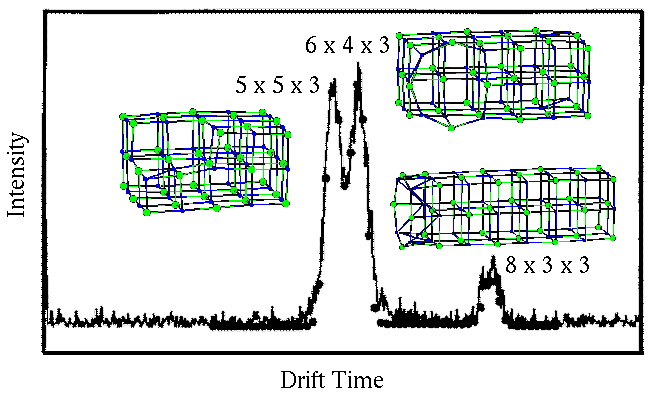|
Research
|
Structural Transformations
The methods that I use to search the energy landscape can be applied to generate paths between structures that are well-separated in configuration space. I have generated pathways for Lennard-Jones clusters with double-funnel energy landscapes and also for sodium chloride clusters. Results for the latter system are described below.NaCl Clusters Experiments on size-selected sodium chloride clusters by Jarrold and coworkers have revealed that for many clusters a number of nanocrystals with different cubiodal shapes are present. The nanocrystals can be distinguished because they have different mobilities in a drift tube. The experimental spectra for NaCl35Cl- is shown below along with the structural assignments.

The populations of the different nanocrystals were observed to evolve with time, and thus rates and activation energies for structural transitions between the nanocrystals could be obtained. However, they had no means to determine the mechanisms of these rearrangements and guessed (wrongly) that they were facilitated by diffusion of atoms over the surface. Using the techniques that I have developed to find pathways on the energy landscape, I have shown that the key steps in these rearrangements involve a glide mechanism where two parts of the cluster slip past each other. An example is given below.

The slip occurs along the plane and direction that are the dominant slip system for dislocations in bulk NaCl crystals. The transformation is a mechanism of plastic deformation. Another mechanism was also found in which the cluster cleaves and the two halves rotate around a common edge (see below). However, the activation energy for this mechanism is much higher and so, although spectacular, is not in fact experimentally relevant.

Associated Publications
NaCl clusters
- J.P.K. Doye and D.J. Wales, J. Chem. Phys. 111, 11070-11079 (1999)
The dynamics of structural transitions in sodium chloride clusters - J.P.K. Doye and D.J. Wales, Phys. Rev. B 59, 2292-2300 (1999)
Structural transitions and global minima of Sodium Chloride Clusters
Lennard-Jones clusters
- J.P.K. Doye, M.A. Miller and D.J. Wales, J. Chem. Phys. 111, 8417-8428
(1999)
Evolution of the Potential Energy Surface with Size for Lennard-Jones Clusters - J.P.K. Doye and D.J. Wales, Z. Phys. D, 40, 194-197 (1997)
Traversing the potential energy surface by eigenvector-following: applications to global optimisation and the structural transformations of clusters